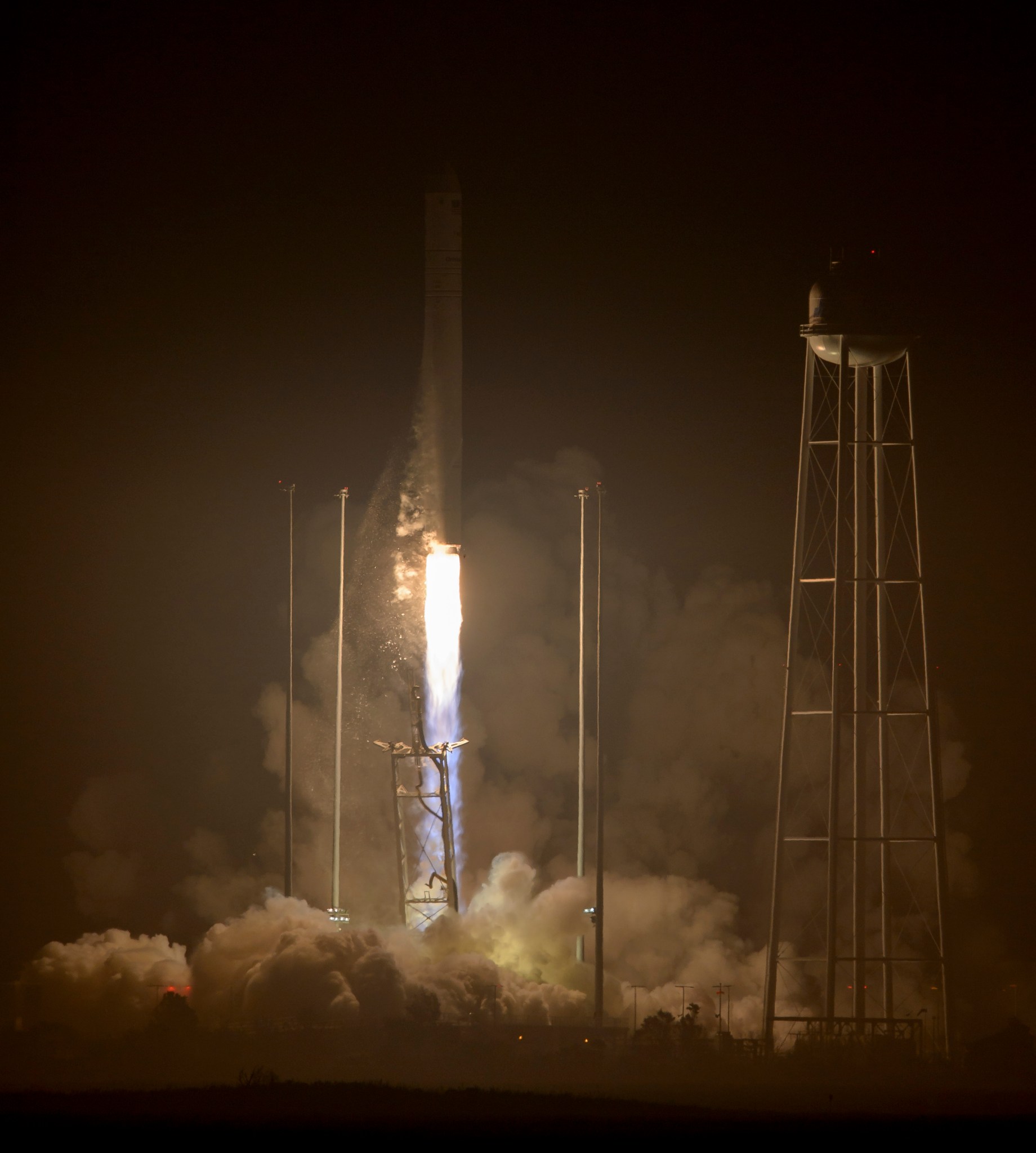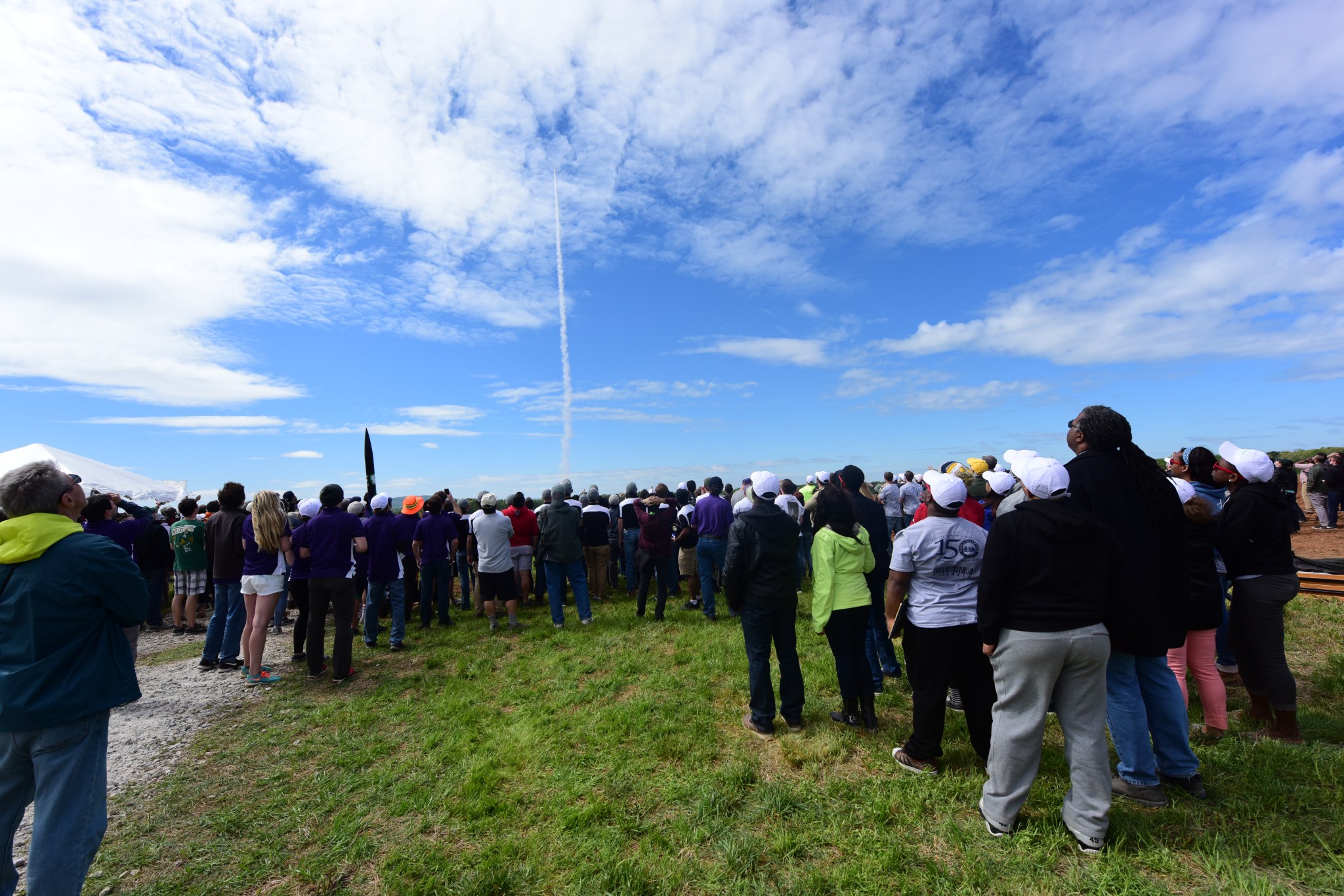In This Week’s Star
- The Pressure is On for SLS Hardware in Upcoming Test
- Reducing Risk is Lifelong Pursuit for New Marshall Safety Chief
- Special Deliveries: New Crew Members, Investigations and Supplies Launch to Space Station
- NASA Selects Student Teams for 2017 Student Launch Rocket Challenge
- Marshall’s Gustavo Martinez Recognized for National Hispanic Heritage Month
- Marshall Team Members’ Stories Show ‘Inclusion Works’
- This Week in NASA History: First U.S. Microgravity Payload-1 Mission Launches — Oct. 22, 1992
- SLS Liquid Hydrogen Tank Featured on ‘This Week @NASA’
The Pressure is On for SLS Hardware in Upcoming Test
By Megan Davidson
Engineers are getting ready to put the pressure on hardware for the world’s most powerful rocket, NASA’s Space Launch System, as part of a test series to ensure each structure can withstand the stresses of launch.
“Not only is this series more cost effective by testing several qualification articles together, but it also helps us to understand how the flight-like hardware will interface together,” said Mike Roberts, mechanical team lead in the Engineering Directorate at NASA’s Marshall Space Flight Center.
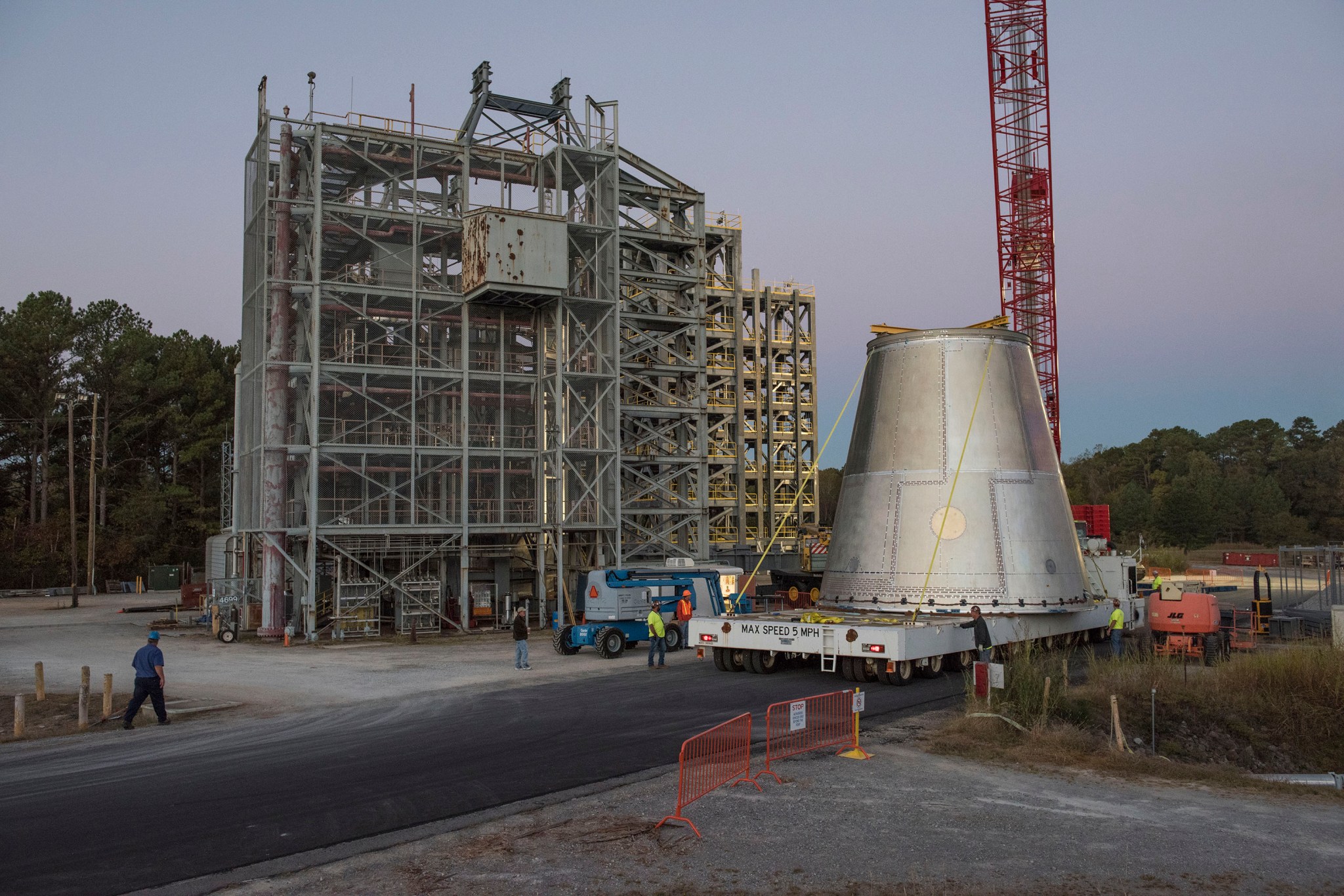
A 65-foot-tall test stand at Marshall is being readied for the upcoming test series, where two simulators and four qualification articles of the upper part of the SLS will be stacked and then pushed, pulled and twisted by forces similar to those experienced in flight. “We have to make sure all the hardware is structurally sound and will not compromise under the incredible amounts of force,” said Dee VanCleave, lead test engineer for the structural loads test at Marshall. “The best way to verify these major structures are ready for launch is to test them.”
The qualification articles and simulators — built almost exact to flight hardware specifications — will be stacked in order from bottom to top in a test structure with “spiders” — hardware with 8-16 legs that span out from the center — that help distribute the load evenly in the test stand.
The pieces are:
- Core stage simulator — a duplicate of the top of the SLS core stage. It was designed and built at Marshall.
- Launch vehicle stage adapter — connects the SLS core stage and the interim cryogenic propulsion stage, a liquid oxygen/liquid hydrogen-based system that will give Orion the big, in-space push needed to fly beyond the moon before it returns to Earth on the first flight of SLS in 2018. It was designed and built by prime contractor Teledyne Brown Engineering of Huntsville.
- Frangible joint assembly — part of the separation system on the SLS. The flight version will have small explosive devices installed that will separate the ICPS from the rest of the rocket in space. Only the structural part of the assembly is included for this test series. It was designed and built by The Boeing Co. in Huntsville and United Launch Alliance of Decatur.
- ICPS — The qualification test article will be filled with liquid nitrogen for testing, rather than liquid oxygen and liquid hydrogen. “Liquid nitrogen is the safest cryogenic media to use for testing,” VanCleave said. The ICPS was designed and built by Boeing and United Launch Alliance.
- Orion stage adapter — connects the Orion to the ICPS. It was designed and built at Marshall.
- Orion spacecraft simulator — a replica of the bottom portion of the exploration vehicle that will carry the crew to space, provide emergency abort capability, sustain the crew during the space travel, and provide safe re-entry from deep-space return velocities. The simulator also was designed and built at Marshall.
The core stage simulator was loaded into the test stand Sept. 21, with the LVSA following Oct. 12. The other qualification articles and Orion simulator will complete the stack later this fall. Testing is scheduled to begin in early 2017.
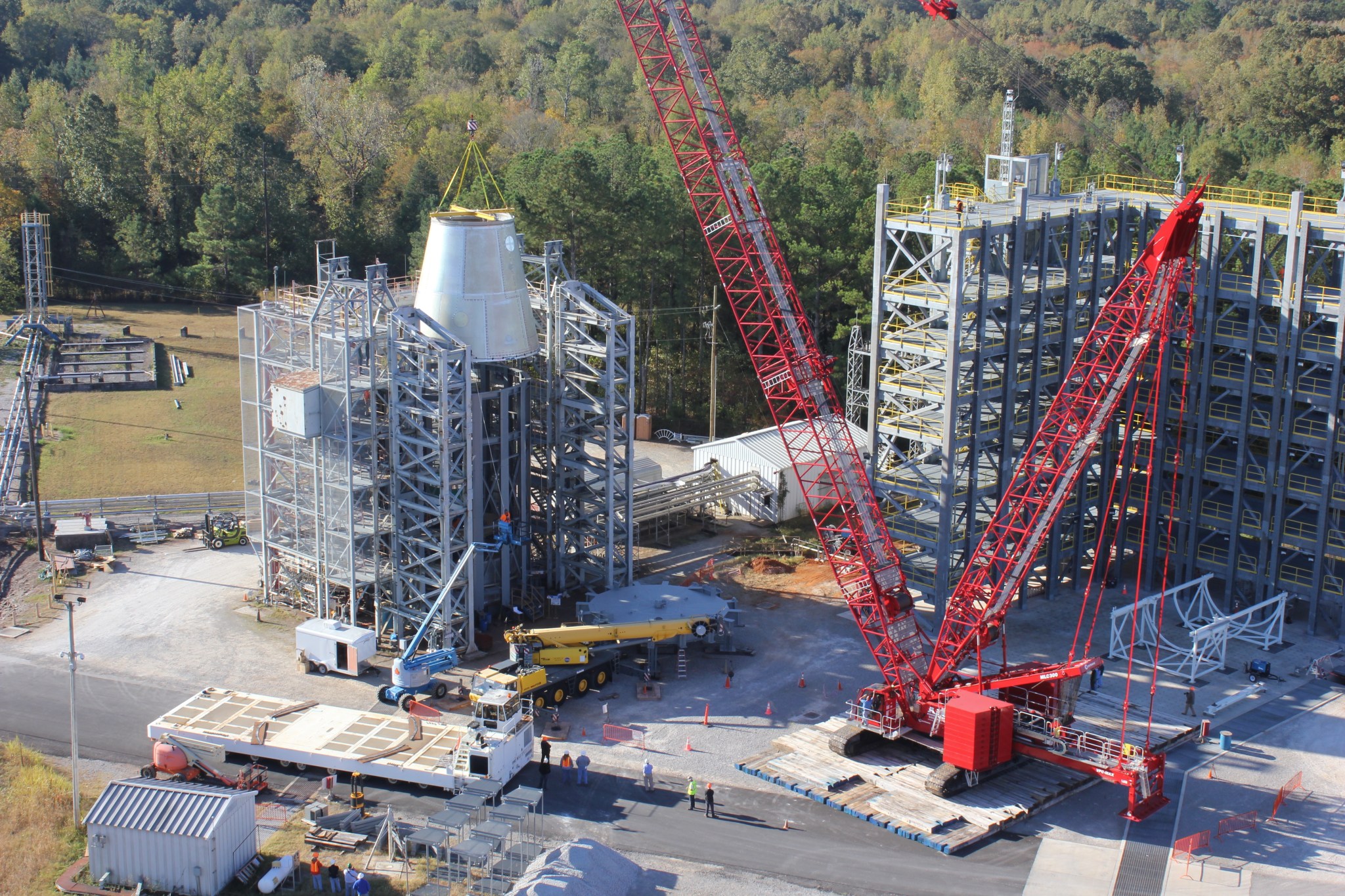
Approximately 50 test cases are planned for the series. The qualification test articles will be outfitted with 28 mechanical load lines, which will use hydraulic pressure to test the hardware. Filled with liquid nitrogen, the ICPS tanks will subjected to pressure as high as 56 pounds per square inch. More than 170,000 pounds of liquid nitrogen will be used in the tanks for most of the load cases, and 500,000 pounds of axial hydraulic force will be applied to the entire test stack. Engineers will not test to failure for this series.
Data will be recorded through 1,900 instrumentation channels, measuring the strain on the test articles, temperature, deflection and other factors. The data will be compared to computer models to verify the integrity of the hardware and ensure it can withstand the forces it will experience during flight. This also will be a type of practice run for assembly operations before the rocket hardware is stacked in the Vehicle Assembly Building at NASA’s Kennedy Space Center ahead of launch.
Davidson, an ASRC Federal/Analytical Services employee, supports the Office of Strategic Analysis & Communications.
Reducing Risk is Lifelong Pursuit for New Marshall Safety Chief
By Kenneth Kesner
Rick Burt remembers his very first engineering and safety lessons came as a child, one of two sons working on the family’s small farm near Columbia, Tennessee, in the 1960s. His dad was a strict teacher on the importance of listening to and watching out for each other, of thinking ahead to recognize potential dangers before tackling any job, especially around the tractor and other machinery.
Formal engineering classes and decades of experience came later. But his dad’s farm curriculum still resonates every single day with Burt, who is now director of Safety and Mission Assurance at NASA’s Marshall Space Flight Center.
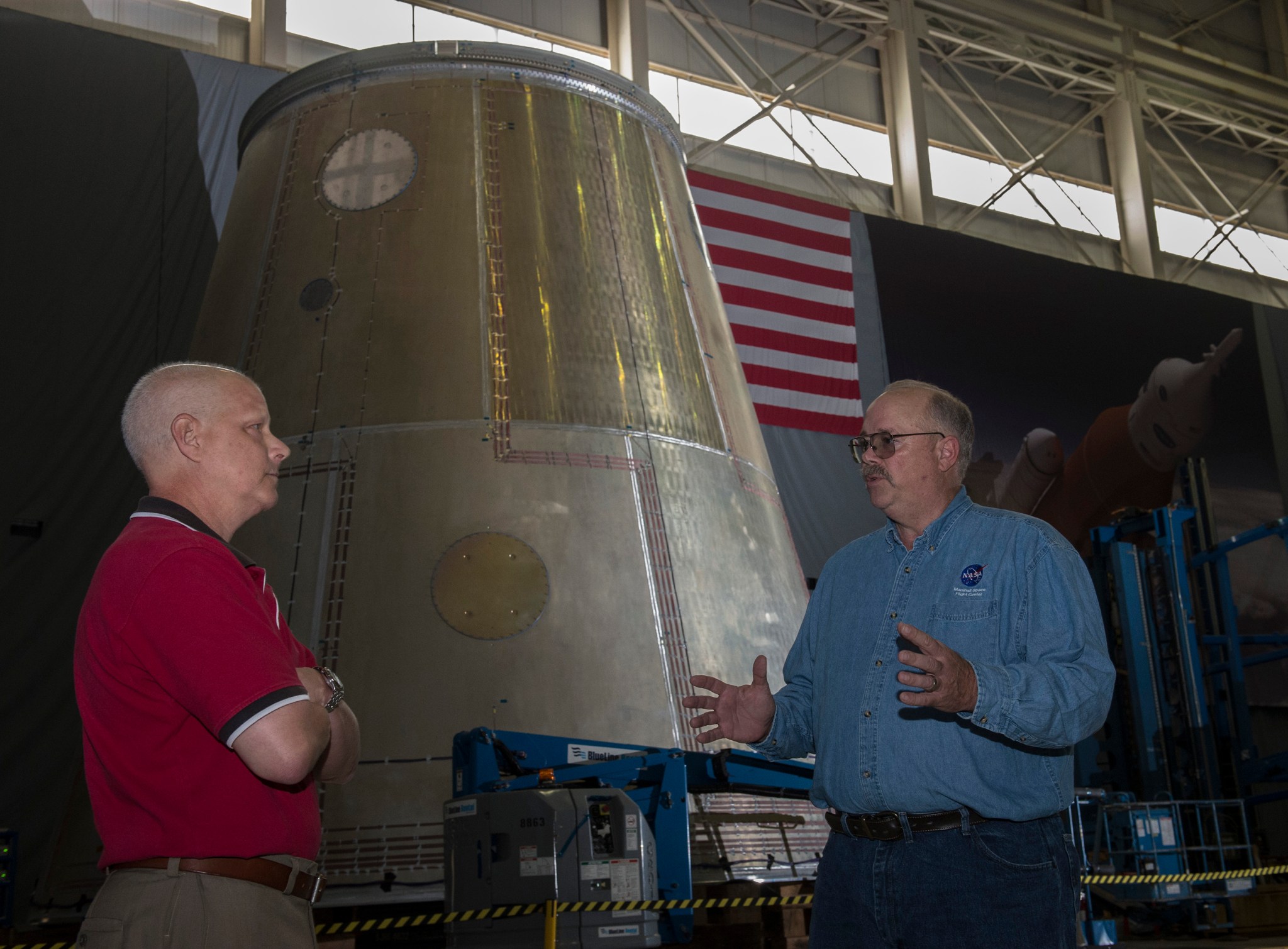
“It does stick with me. When you think about the safety aspects of anything you do, it molds all your thought processes,” he said. “That feeds right in to everything we do in the space program, and particularly our development of NASA’s Space Launch System: You identify the hazards, determine how to mitigate those hazards and reduce the amount of risk.”
Burt was previously chief safety and mission assurance officer for SLS, the massive rocket that will take humans on exploration missions farther into deep space than ever before, and a journey to Mars. In his new assignment he is responsible for safety, reliability and quality engineering for the programs and activities across the entire center.
“Risk is inherent in exploration,” Burt said. “My own mission, every day, is to make sure everyone who works here, in every kind of job, whether NASA employee or contractor, thinks about that balance of safety and risk, and feels absolutely comfortable reporting, talking and asking about any safety issues, without worry about consequences.”
In high school, Burt exceled at math and science, and by then knew he wanted to be an engineer. He went to Tennessee Technological University in Cookeville because it had one of the best mechanical engineering programs in the country, and received several job offers with his bachelor’s degree in 1978. He chose a position with the Tennessee Valley Authority and began working with teams building the Hartsville Nuclear Power Plant east of Nashville. He met his wife, Susan, who also worked for TVA, riding a commuter van to the plant every day.
Burt transferred to the Watts Barr nuclear plant in Spring City, Tennessee in 1984. In 1987, he was asked to supervise the engineering for modifications at the Browns Ferry Nuclear Plant in Athens, Alabama. When that temporary position became permanent, the Burts moved to Rogersville, Alabama, where they still reside in the home where they raised their daughter and son.
In 1990, when NASA had openings at Marshall in the Space Shuttle Program, he seized the opportunity. NASA was then preparing for the Return to Flight following the space shuttle Challenger accident and Burt was soon engrossed in the work of the shuttle Reusable Solid Rocket Motor Project office.
“I viewed an engineering job at NASA as the pinnacle of the profession, especially as we examined all the hardware and procedures to get the shuttle Discovery ready for safe flight after a two-and-a-half-year period when we weren’t launching crews into space,” Burt said. “It is just so exciting to be part of something so special as human spaceflight. I really wanted to be a part of that.”
His experience includes serving as deputy manager and chief engineer of the motor project office; deputy manager of the Space Shuttle Projects Office; manager of the Ares 1 First Stage Program; and manager of the Marshall Engineering Directorate’s Test Laboratory. He became chief safety officer for the Space Launch System in 2011 and Marshall’s Safety and Mission Assurance director in July 2016.
“It’s an extraordinary feeling to know that you’re being entrusted and empowered to lead such a critical team, both for the center and the agency,” Burt said.
Kesner, an ASRC Federal/Analytical Services employee, supports the Office of Strategic Analysis & Communications.
Special Deliveries: New Crew Members, Investigations and Supplies Launch to Space Station
Two launches to the International Space Station this week will make for a few hectic days on the orbiting laboratory.
First, the current crew of the space station soon will have dozens of new scientific investigations with cargo launched Oct. 17 on NASA’s latest commercial resupply services mission from the agency’s Wallops Flight Facility. Orbital ATK’s Cygnus spacecraft lifted off at 6:45 p.m. from the Mid-Atlantic Regional Spaceport’s Pad 0A on the upgraded Antares 230 rocket carrying more than 5,100 pounds of cargo.
Before it arrives, the second launch of the week will double the size of the station’s crew.
Three new crew members representing the United States and Russia launched from the Baikonur Cosmodrome in Kazakhstan at 3:05 a.m. on Oct. 19. The Soyuz spacecraft carrying NASA astronaut Shane Kimbrough and cosmonauts Sergey Ryzhikov and Andrey Borisenko of the Russian space agency Roscosmos is scheduled to dock at 5 a.m. Oct. 21.
The arrival of Kimbrough, Ryzhikov and Borisenko will return the station’s crew complement to six. The three will join Expedition 49 Commander Anatoli Ivanishin of Roscosmos, NASA astronaut Kate Rubins and Japan Aerospace Exploration Agency astronaut Takuya Onishi.
After the crew’s arrival, they will focus on the approaching cargo spacecraft. Onishi and Rubins will use the station’s robotic arm to grapple Cygnus around 5 a.m. Oct. 23.
The cargo flight is the first flight on the upgraded Antares 230 launch vehicle, and the first to launch from Wallops since an Antares rocket and its Cygnus spacecraft were lost in October 2014. It’s also the third flight of an enhanced Cygnus spacecraft featuring a greater payload capacity, supported by new fuel tanks and UltraFlex solar arrays.
“It’s great to see launches to the International Space Station happening again from the Virginia coast — and it shows what can be accomplish with a close partnership of federal and state agencies, along with the U.S. industry, all working together,” said NASA Administrator Charles Bolden.
The cargo aboard the Cygnus will support dozens of new and existing investigations as the space station crews of Expeditions 49 and 50 contribute to about 250 science and research studies. The new experiments include studies on fire in space, the effect of lighting on sleep and daily rhythms, collection of health-related data and a new way to measure neutrons.
Kimbrough, Ryzhikov and Borisenko are scheduled to remain aboard the station until late February. Rubins, Ivanishin and Onishi will return to Earth Oct. 30.
The Cygnus spacecraft will remain at the space station until November before its destructive reentry into Earth’s atmosphere, disposing of about 3,000 pounds of trash.
NASA Selects Student Teams for 2017 Student Launch Rocket Challenge
By Christopher Blair
NASA has selected 60 student teams from 23 states to participate in the 2016-2017 NASA Student Launch challenge, to be held April 5-9 near NASA’s Marshall Space Flight Center.
Now in its 17th year, NASA Student Launch is an eight-month-long activity, offering middle school to college-aged students a chance to design, build and launch high-powered, reusable rockets to one-mile-above ground level.
The Academic Affairs Office at Marshall manages Student Launch to further NASA’s major education goal of attracting and encouraging students to pursue degrees and careers in the STEM fields of science, technology, engineering and mathematics.
“We’re honored to continue engaging students in experiential activities that connect STEM skills learned in school toward meaningful applications in real-world, working environments,” said Tammy Rowan, manager of Marshall’s Academic Affairs Office. “Throughout the process, students interact with NASA scientists and engineers, gaining advice and better preparing them for success in future aerospace and engineering careers.”
A new feature for this year’s college and university teams is to select one of three payload options to design, test and demonstrate during launch. The choices include an onboard camera system capable of identifying and differentiating targets; a system capable of controlling launch vehicle roll after motor burnout; or a container capable of protecting a payload throughout flight. Middle and high school teams will continue to design their own scientific or engineering payload.
Interested teams were required to submit a proposal for comprehensive review by NASA subject matter experts. Once complete, teams were chosen based on detailed outlines of their rocket, its recovery system, payload, safety and educational engagement plans.
Student Launch mimics NASA’s project life cycle, requiring teams to complete several technical design reviews and presentations with the NASA workforce. The challenge contributes to the future development of NASA projects and aligns with current research, such as addressing potential technical issues during the agency’s Journey to Mars or to other deep space destinations on NASA’s Space Launch System rocket.
Marshall’s Academic Affairs Office manages Student Launch with funding and leadership provided by NASA’s Office of Education, NASA’s Human Exploration and Operations Mission Directorate, and longtime corporate sponsor Orbital ATK Aerospace Group of Promontory, Utah.
To learn more about NASA’s Student Launch challenge, click here.
Blair, an ASRC Federal/Analytical Services employee, supports the Office of Strategic Analysis & Communications.
Marshall’s Gustavo Martinez Recognized for National Hispanic Heritage Month
In observance of National Hispanic Heritage Month, Gustavo Martinez, a propulsion engineer at NASA’s Marshall Space Flight Center, is featured in a video profile posted to NASA and Marshall’s websites. Martinez, a first-generation American of Mexican descent, earned his bachelor’s and master’s in mechanical engineering from the University of Texas at El Paso. He works in the Liquid Engine System Branch of Marshall’s Propulsion Systems Department, supporting RS-25 engine systems analysis and test preparations for NASA’s Space Launch System. National Hispanic Heritage Month is celebrated from Sept. 15-Oct. 15, honoring the cultures and contributions of Americans whose ancestors originated from Spain, Mexico, the Caribbean and Central and South America. The observation started in 1968 as Hispanic Heritage Week under President Lyndon Johnson and was expanded into law by President Ronald Reagan in 1988. (NASA/MSFC)
Marshall Team Members’ Stories Show ‘Inclusion Works’
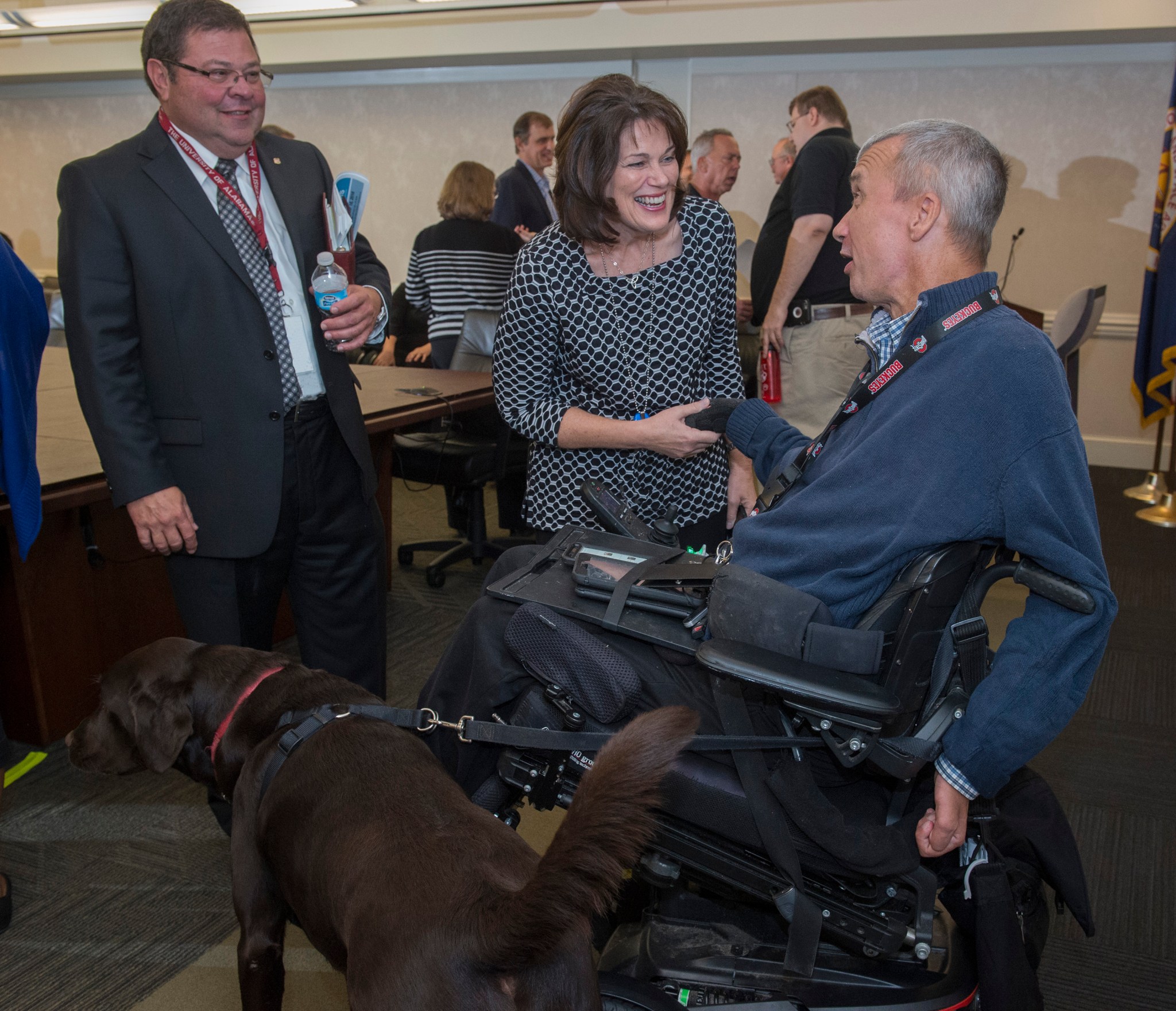
Jim Duffy, right, with his dog Macchiato, talks with NASA Marshall Space Flight Center Associate Director Robin Henderson, center, and Paul Gilbert, deputy manager of the Flight Programs and Partnerships Office, after the National Disability Employment Awareness Month program at Marshall Oct. 18. “Inclusion Works” is the theme this year, and Marshall team members Duffy, Victoria Garcia, Traci Matthews and Matthew Pettus shared stories about how the welcoming environment of NASA and Marshall affords them the opportunity to be part of the diverse team contributing top professional skills and unique perspectives to the agency’s missions. The event was sponsored by the Marshall Office of Diversity and Equal Opportunity. (NASA/MSFC/Emmett Given)
This Week in NASA History: First U.S. Microgravity Payload-1 Mission Launches — Oct. 22, 1992
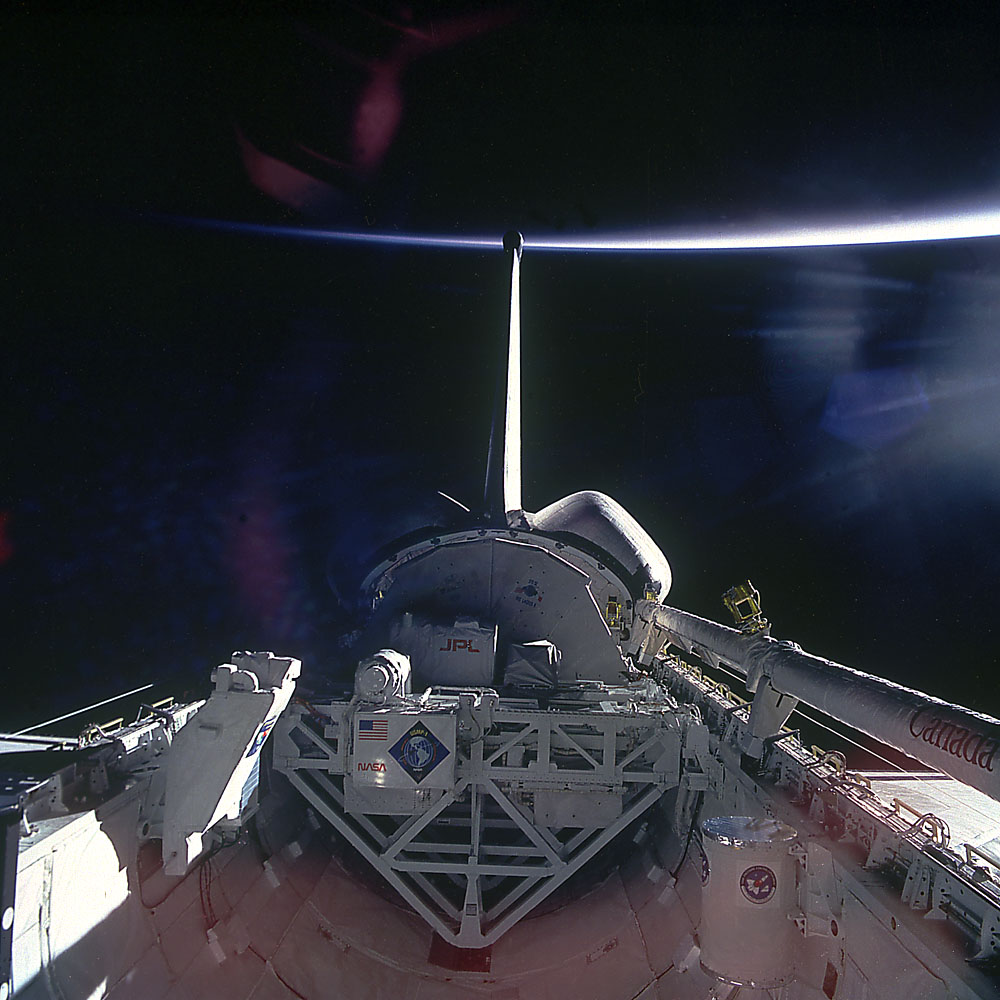
This week in 1992, space shuttle Columbia launched from NASA’s Kennedy Space Center. STS-52 was the first flight of the U.S. Microgravity Payload-1, a complement of three experiments mounted on two connected Spacelab Multipurpose Experiment Support Structures in the cargo bay of Columbia. Science teams on Earth remotely commanded and monitored instruments and analyzed data from workstations at the Spacelab Mission Operation Control Facility at NASA’s Marshall Space Flight Center. Today the Payload Operations Integration Center at Marshall serves as “science central” for the International Space Station, working 24/7, 365 days a year in support of scientific experiments on the orbiting laboratory. The NASA History Program is responsible for generating, disseminating and preserving NASA’s remarkable history and providing a comprehensive understanding of the institutional, cultural, social, political, economic, technological and scientific aspects of NASA’s activities in aeronautics and space. For more pictures like this one and to connect to NASA’s history, visit the History Program’s webpage. (NASA)
SLS Liquid Hydrogen Tank Featured on ‘This Week @NASA’
The completion of welding on the liquid hydrogen tank that will power the Space Launch System’s first flight is featured in the latest edition of “This Week @NASA,” a weekly video program broadcast nationwide on NASA-TV and posted online.
Teams recently completed welding the tank at NASA’s Michoud Assembly Facility. It will hold the rocket fuel for SLS and Orion’s first spaceflight test in 2018. Standing more than 130 feet tall, the liquid hydrogen tank is the largest cryogenic fuel tank for a rocket in the world.
It and a liquid oxygen tank will hold about 733,000 gallons of propellant and feed the rocket’s four RS-25 engines — to produce a total of 2 million pounds of thrust. SLS will have the power and payload capacity needed to carry crew and cargo on future exploration missions to deep space, including NASA’s Journey to Mars.
View this and previous episodes at “This Week @NASA” or at https://www.youtube.com/user/NASAtelevision.


























